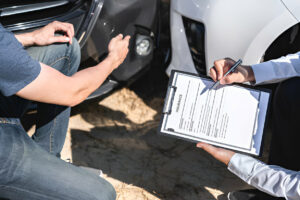In the unfortunate event of a road traffic accident where you are found to be at fault, getting your vehicle repaired can feel overwhelming. However, knowing the steps involved, the costs, and your obligations can make the situation easier to navigate. Here is a detailed breakdown of how to handle the vehicle repairs process in an at-fault accident claim.
1. Understanding Fault in Vehicle Accidents
An at-fault accident means you are held responsible for the collision and the damages that result from it. The driver deemed accountable for the accident must cover the costs associated with repairs and any other damages incurred.
2. What to Do After the Accident
Your priority should be ensuring everyone’s safety. After securing everyone’s safety, take the following steps:
- Contact the Police if necessary.
- Exchange Information with the other driver(s) involved.
- Document the Incident: Take photos, make notes, and gather relevant evidence, like witness statements.
- Contact an Accident Management Company: Consider seeking assistance from a claims management service to help guide you through the process.
3. Documenting the Vehicle Damages
For your claim to be successful, it’s essential to gather comprehensive evidence of the damage caused to your vehicle. This includes:
- Explicit photos of all damage to your car.
- Any witness statements or police reports that can support your claim.
- A detailed description of the incident and how the damage occurred.
4. Choosing a Vehicle Repair Garage
When it comes to repairing your vehicle, you have options:
- Approved Garages: You can choose from a list of garages approved by your insurance or accident management company.
- Independent Garages: Sometimes, you may choose a garage that is not affiliated with your insurer. If so, ensure they are reputable and can work with your insurance provider.
5. Repairs Estimate
It’s essential to understand how much the repairs will cost. Here’s what you need to know:
- Multiple Estimates: Your insurance may require more than one estimate for repair costs.
- Understanding Cost Factors: The forecast will depend on the severity of the damage, the make and model of your vehicle, and any parts needed.
6. Filing Your Claim
Once all documentation is gathered, it’s time to file your claim. Ensure you provide all the required documents, such as:
- Photos of the damage.
- The police report (if applicable).
- The repair estimate.
- Any other supporting evidence?
7. Insurance Coverage
Your insurance coverage will majorly affect how the repair process is handled. In an at-fault claim, your insurance will typically cover:
- Your Vehicle Repairs: If you have comprehensive insurance.
- Third-Party Damages: Repairs are made to the other vehicle(s) involved.
It’s essential to check your policy to understand what is covered, mainly if you’re found at fault.
8. Managing Expenses
While your insurance may cover most repair costs, some expenses may not be included. For example, you might have to pay for:
- Excess or Deductibles: If your insurance has an excess clause, you’ll be responsible for paying this amount before the insurer covers the rest.
- Additional Repair Costs: If repairs exceed the vehicle’s value, your insurance might classify it as a total loss, and you’ll have to negotiate with them about compensation.
How to Win an At-Fault Accident Claim
Though an at-fault claim may initially seem daunting, the key is thorough documentation, understanding your insurance policy, and working with an experienced claims management team or personal injury lawyer. By following all procedures carefully, you can ensure that the process goes smoothly and that you receive the appropriate compensation.
Frequently Asked Questions
Q: Do I need an appointment to get a repair estimate?
A: Usually, you do not need an appointment for a repair estimate. You can visit the repair shop during their operational hours.
Q: Do I have to get more than one repair estimate?
A: This depends on your insurance provider. Some may require more than one estimate, while others may accept just one.
Q: What if the repair costs exceed the value of the vehicle?
A: If the repair costs surpass the vehicle’s value, your insurance provider will decide whether to pay for the repairs or write off the car as a total loss.
Q: Who will pay for my car damage if I was at fault?
A: If you’re at fault, your insurance will cover the other party’s vehicle repair costs and medical expenses. However, your insurance premiums will likely rise at the time of renewal.
Q: What if the repair shop and my insurance disagree about repair costs?
A: If there’s a disagreement, the repair shop will contact your insurance provider to resolve the issue. They may negotiate the costs to reach a fair agreement.






